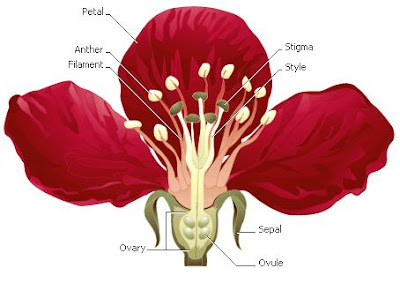 All flowers share several basic features. Sepals, protective coverings that are closed over the bud before it blooms, are the outermost flower parts. One step inward lie the petals, which serve to attract pollinators using both coloration and scent-producing glands. Inside the petals are the flower's sexual organs, the stamens and pistil. Each stamen, the pollen producing part of the flower, includes an anther and a filament. At the center of the flower is the pistil, composed of a stigma, a style, and an ovary. Within the ovary is a small cavity that contains the ovule, an egg-shaped structure that, when fertilized, eventually becomes a seed.
All flowers share several basic features. Sepals, protective coverings that are closed over the bud before it blooms, are the outermost flower parts. One step inward lie the petals, which serve to attract pollinators using both coloration and scent-producing glands. Inside the petals are the flower's sexual organs, the stamens and pistil. Each stamen, the pollen producing part of the flower, includes an anther and a filament. At the center of the flower is the pistil, composed of a stigma, a style, and an ovary. Within the ovary is a small cavity that contains the ovule, an egg-shaped structure that, when fertilized, eventually becomes a seed.
Flowers typically are composed of four parts, or whorls, arranged in concentric rings attached to the tip of the stem. From innermost to outermost, these whorls are the (1) pistil, (2) stamens, (3) petals, and (4) sepals.
Pistil
The innermost whorl, located in the center of the flower, is the female reproductive structure, or pistil. Often vase-shaped, the pistil consists of three parts: the stigma, the style, and the ovary. The stigma, a slightly flared and sticky structure at the top of the pistil, functions by trapping pollen grains, the structures that give rise to the sperm cells necessary for fertilization. The style is a narrow stalk that supports the stigma. The style rises from the ovary, a slightly swollen structure seated at the base of the flower. Depending on the species, the ovary contains one or more ovules, each of which holds one egg cell. After fertilization, the ovules develop into seeds, while the ovary enlarges into the fruit. If a flower has only one ovule, the fruit will contain one seed, as in a peach. The fruit of a flower with many ovules, such as a tomato, will have many seeds. An ovary that contains one or more ovules also is called a carpel, and a pistil may be composed of one to several carpels.
Stamens
The next whorl consists of the male reproductive structures, several to many stamens arranged around the pistil. A stamen consists of a slender stalk called the filament, which supports the anther, a tiny compartment where pollen forms. When a flower is still an immature, unopened bud, the filaments are short and serve to transport nutrients to the developing pollen. As the flower opens, the filaments lengthen and hold the anthers higher in the flower, where the pollen grains are more likely to be picked up by visiting animals, wind, or in the case of some aquatic plants, by water. The animals, wind, or water might then carry the pollen to the stigma of an appropriate flower. The placement of pollen on the stigma is called pollination. Pollination initiates the process of fertilization.
Petals
Petals, the next whorl, surround the stamens and collectively are termed the corolla. Many petals have bright colors, which attract animals that carry out pollination, collectively termed pollinators. Three groups of pigments—alone or in combination—produce a veritable rainbow of petal colors: anthocyanins yield shades of violet, blue, and red; betalains create reds; and carotenoids produce yellows and orange. Petal color can be modified in several ways. Texture, for example, can play a role in the overall effect—a smooth petal is shiny, while a rough one appears velvety. If cells inside the petal are filled with starch, they create a white layer that makes pigments appear brighter. Petals with flat air spaces between cells shimmer iridescently.
Sepals
The sepals, the outermost whorl, together are called the calyx. In the flower bud, the sepals tightly enclose and protect the petals, stamens, and pistil from rain or insects. The sepals unfurl as the flower opens and often resemble small green leaves at the flower’s base. In some flowers, the sepals are colorful and work with the petals to attract pollinators.
related articles:



